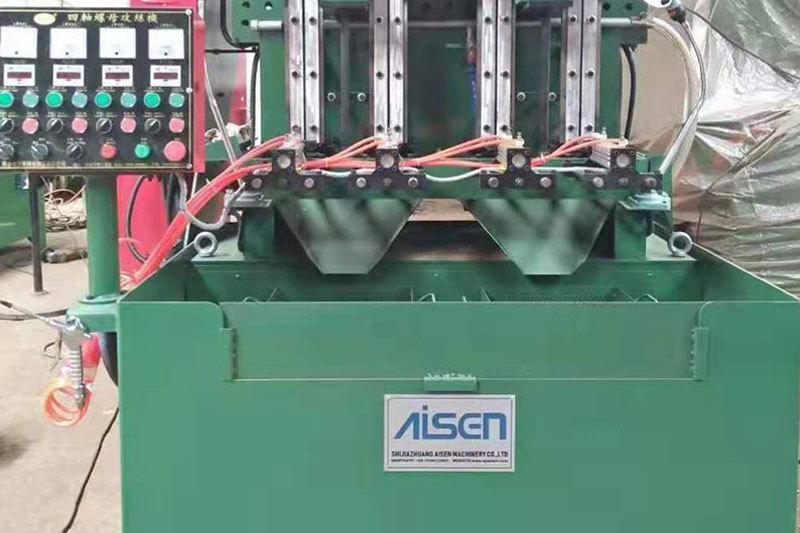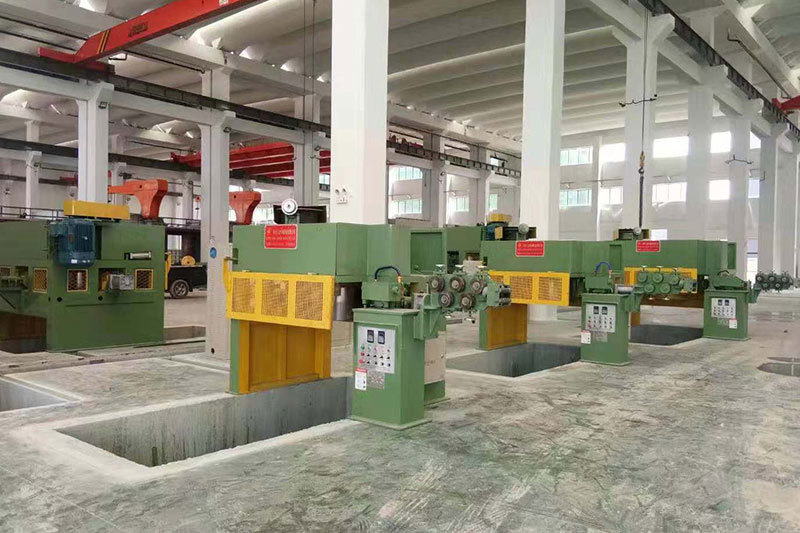How to Effectively Train Your Staff on Using Bolt Cold Forging Machines for Maximum Efficiency
Summary:
How to Effectively Train Your Staff on Using Bolt Cold Forging Machines for Maximum Efficiency
Introduction to Bolt Cold Forging Machines
In the intricate world of manufacturing, bolt cold forging machines play a pivotal role in producing high-quality fasteners with precision and efficiency. These machines utilize a method that shapes metal at room temperature, resulting in strong, durable compone

How to Effectively Train Your Staff on Using Bolt Cold Forging Machines for Maximum Efficiency
Introduction to Bolt Cold Forging Machines
In the intricate world of manufacturing, bolt cold forging machines play a pivotal role in producing high-quality fasteners with precision and efficiency. These machines utilize a method that shapes metal at room temperature, resulting in strong, durable components that are essential in various industries. To harness the full potential of these machines, **effective training of your staff is crucial**. This guide will delve into the key aspects of training your employees on the operation, maintenance, and safety protocols associated with bolt cold forging machines.
Table of Contents
- Understanding Cold Forging: A Brief Overview
- Importance of Training Your Staff on Bolt Cold Forging Machines
- Core Components of Bolt Cold Forging Machines
- Training Methods and Effective Strategies
- Hands-On Training and Practical Experience
- Safety Protocols in Cold Forging Operations
- Maintenance and Troubleshooting Training
- Evaluating the Effectiveness of Training Programs
- Conclusion
- Frequently Asked Questions
Understanding Cold Forging: A Brief Overview
Cold forging is a manufacturing process that involves shaping metal without the application of heat. This method enhances the strength of the material and allows for precise control over the final product's dimensions. Bolt cold forging machines are specifically designed to create fasteners and other components with high tensile strength, making them ideal for various applications in automotive, aerospace, and construction industries.
The **key benefits of cold forging** include improved mechanical properties, reduced material waste, and the ability to produce complex shapes with tight tolerances. Understanding these principles is essential for your staff as they prepare to engage with the machinery.
Importance of Training Your Staff on Bolt Cold Forging Machines
Training your staff on bolt cold forging machines is not just a regulatory requirement; it is a strategic investment in your organization's efficiency and safety. Proper training ensures that employees are well-equipped to operate machinery correctly, which reduces the likelihood of errors that could lead to defects in production or accidents in the workplace.
Moreover, well-trained staff are more confident and productive, contributing to lower turnover rates and improved workplace morale. By creating a culture of continuous learning and development, companies can adapt to new technologies and methods, ensuring longevity and competitiveness in the industry.
Core Components of Bolt Cold Forging Machines
Before initiating training, it is vital for employees to familiarize themselves with the core components of bolt cold forging machines. Understanding the function of each part enhances their operational knowledge and ability to troubleshoot issues. Key components include:
1. Feed Mechanism
The feed mechanism is responsible for delivering raw material to the machine. Staff must learn how to adjust and maintain this component to ensure a smooth flow of material.
2. Die Sets
Die sets shape the material during the forging process. Training should cover how to properly install and align die sets for optimal performance.
3. Press System
The press system exerts force on the material, shaping it into the desired form. Understanding the pressure settings and calibration is crucial for safety and product quality.
4. Control Panel
The control panel manages the machine's operations. Employees should receive comprehensive training on how to navigate and utilize the control system effectively.
Training Methods and Effective Strategies
Implementing effective training methods is essential to ensure that employees grasp the complexities of operating bolt cold forging machines. Consider the following strategies:
1. **Structured Training Programs**
Develop a structured training program that includes theoretical knowledge, practical demonstrations, and assessments. A clear outline helps employees understand what is expected of them throughout the training process.
2. **Utilize Multimedia Learning Tools**
Incorporating videos, diagrams, and interactive simulations can enhance understanding. These tools cater to different learning styles and can make complex concepts more accessible.
3. **Mentorship and Peer Learning**
Pairing less experienced staff with seasoned operators fosters an environment of mentorship. This approach allows for hands-on learning and knowledge sharing, which can be particularly effective in a manufacturing setting.
Hands-On Training and Practical Experience
Theoretical knowledge alone is insufficient for mastering bolt cold forging machines. Hands-on training is critical. This section will cover how to structure effective practical training sessions.
1. **Simulated Training Sessions**
Before working on actual machines, conduct simulated training sessions where employees can practice operating controls and managing the machinery in a controlled environment.
2. **Supervised Operation**
Allow trainees to operate the machine under the supervision of experienced personnel. Continuous feedback during this phase helps reinforce learning and address any mistakes in real-time.
3. **Regular Skill Assessments**
Conduct regular assessments to evaluate employees' understanding and skills. These evaluations can take the form of practical tests, quizzes, or performance reviews.
Safety Protocols in Cold Forging Operations
Safety is a paramount concern in any manufacturing environment, particularly when operating heavy machinery such as bolt cold forging machines. Training should emphasize **the following safety protocols**:
1. **Personal Protective Equipment (PPE)**
Ensure that all employees are equipped with the necessary PPE, including gloves, safety glasses, and ear protection. Training should stress the importance of wearing appropriate gear at all times.
2. **Machine Safety Features**
Familiarize staff with the machine's safety features, such as emergency stop buttons and safety guards. This knowledge is vital for incident prevention.
3. **Emergency Procedures**
Conduct drills on emergency procedures, ensuring that staff knows how to respond to incidents effectively. Regularly review these protocols to maintain awareness.
Maintenance and Troubleshooting Training
Regular maintenance is essential for the longevity and efficiency of bolt cold forging machines. Training programs should include modules on maintenance and troubleshooting.
1. **Scheduled Maintenance Procedures**
Train staff on developing and implementing scheduled maintenance procedures to ensure machines operate at their peak performance. This includes routine checks and servicing of components.
2. **Common Issues and Solutions**
Provide employees with a comprehensive list of common issues that may arise during operation and their respective solutions. Knowledge of troubleshooting can significantly reduce downtime.
Evaluating the Effectiveness of Training Programs
To ensure the training program is successful, it is essential to evaluate its effectiveness continuously. Consider these evaluation methods:
1. **Feedback Surveys**
Collect feedback from participants on the training process. Understanding their perspectives can help refine future training modules.
2. **Performance Metrics**
Establish performance metrics to assess the impact of training on production efficiency, quality control, and safety incidents.
3. **Ongoing Training Opportunities**
Encourage continuous learning by offering ongoing training opportunities. This ensures that staff remain updated on technology advancements and best practices.
Conclusion
Training your staff on bolt cold forging machines is a multifaceted process that requires careful planning and execution. By focusing on hands-on experience, safety protocols, and continuous evaluation, organizations can create a knowledgeable and skilled workforce capable of maximizing the efficiency of their manufacturing operations. Investing in robust training programs not only enhances productivity but also fosters a culture of safety and excellence in the workplace.
Frequently Asked Questions
1. What is the importance of cold forging compared to other methods?
Cold forging enhances the strength of metal components without the need for heat, resulting in products with superior mechanical properties and reduced material waste.
2. How long does it take to train staff on bolt cold forging machines?
The duration of training varies depending on the complexity of the machinery and the prior experience of the staff. Generally, a comprehensive program can range from a few days to several weeks.
3. What safety measures should be in place during cold forging operations?
Safety measures include the use of personal protective equipment, regular safety audits, and ensuring all safety features of the machinery are operational.
4. Can training be conducted online?
Yes, many aspects of training can be conducted online, especially theoretical components. However, hands-on training is essential for practical skill development.
5. How can we assess the effectiveness of our training program?
Effectiveness can be evaluated through feedback surveys, performance metrics, and the incidence of errors or accidents post-training. Ongoing assessments help maintain high standards.
PREVIOUS:
Latest News
AISEN Four axis nut tapping machine ready for shipment to Russia
Four axis nut tapping machine for DIN934 M8,M10 Standard hex nut is ready for shipping to Russia by land transportation.
AISEN machinery inverted wire drawing machine
We hope to cooperate with more customers for mutual development and benefits. You are welcome to contact us









